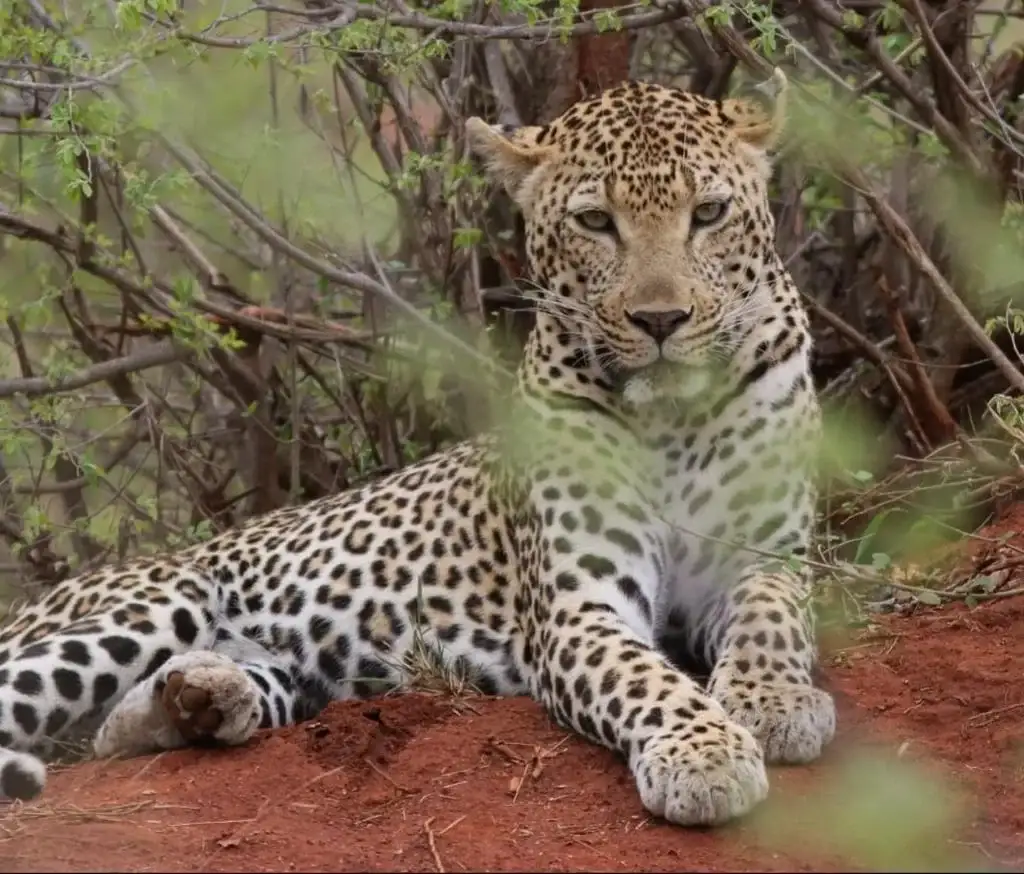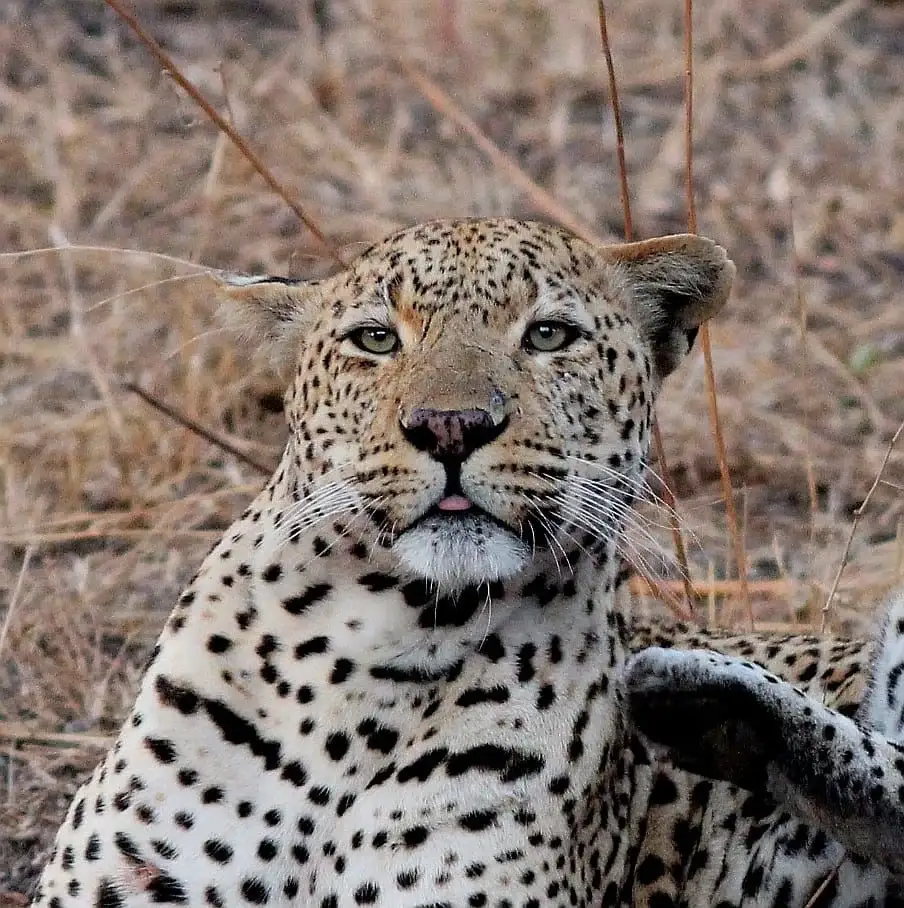This feline is known for being excellent at stalking its prey, hiding high in the limbs of a large, leafy tree or buried in the shadows of shrubbery. It has a reputation for being a little timid, and because it is a nocturnal species, you are unlikely to see them during the heat of the day.
A member of the rather distinguished Big 5, which is made up of elephant (Loxodonta Africana), lion (Panthera Leo), buffalo (Syncerus Caffer), rhino (Ceratotherium Simum), and of course, the leopard (Panthera Pardus).

Kruger National Park is a world-renowned game reserve located in South Africa that is home to a diverse range of wildlife, including the majestic leopard. Leopards are one of the most elusive big cats in Kruger National Park and spotting them in the wild is an unforgettable experience.
Physical Appearance
You can identify most leopards by their light colour and distinctive dark spots. Those spots are called rosettes, because they resemble the shape of a rose. These patterns camouflage their bodies as they move through the grass and trees. Leopards are the second-largest cats in Africa, after lions, with a typical body weight that ranges from 60 to 70 kilograms and a height that ranges from approximately two-thirds to three-quarters of a metre at the shoulders.
The Hunt
The leopard's hunting technique is to either ambush its prey or to stalk it. In either instance, it tries to get as close as possible to its target. It then makes a brief and explosive charge (up to 60km/h), pouncing on its prey and dispatching it with a bite to the neck. Leopards do not have the aptitude to chase their quarry over any kind of distance and will give up if the initial element of surprise is lost and the intended victim gets away. Leopards eat a variety of food, from wildebeest to fish, but most of their diet comes in the form of antelope.
Leopards can carry animals heavier than themselves and will often drag their prey into the fork of a tree several metres off the ground. This protects the carcass against scavengers and allows a few days of undisturbed feeding. Leopards eat on average about a third of the carcass of the animal they kill, and this works out at roughly 400kg of meat per leopard each year. This means that leopards probably need just over a kilogram of meat a day. They will often lick the fur off the carcass of its prey before it feeds, starting with the thighs or the chest.

Raising Cubs
Male and female leopards spend only a brief time together while they are mating and then go their separate ways. The female will then raise the cubs on her own. Leopards can survive for long periods without drinking, satisfying all their moisture needs from their prey.
Leopard cubs are born with barely visible spots. The mother hides her cubs and moves them from one safe location to the next until they are old enough to begin playing and learning to hunt. When the cubs are about two years old, they live on their own. But the maternal bonds are strong, and offspring sometimes have reunions with their mothers.
Leopard Territory
Leopards are highly adaptable creatures, capable of living in semi-desert conditions as well as dense subtropical bush. Their territories can also vary in size from 10 square kilometres to several hundred square kilometres. Leopards scratch trees and use urine to mark their turf. A male leopard will defend his territory against other males but will share his territory with females.
Habitat
These cats are distributed across a huge area, stretching from sub-Saharan Africa to West Asia and the Middle East, reaching South and Southeast Asia and Siberia. Leopards are found in a wide variety of habitats including savanna and rainforest, grasslands, desert and semi-desert regions of southern Africa, woodlands, and riverine forests. Kruger National Park is home to a large population of leopards, estimated to be between 1,000 to 1,500 individuals.
Threats & Enemies
Leopards in Kruger National Park face several threats, including habitat loss, poaching, and conflict with humans. The park has implemented several conservation measures to protect these mystifying cats, including anti-poaching patrols and the establishment of protected areas where leopards can thrive. Additionally, the park works with local communities to reduce conflict between leopards and people by implementing measures such as livestock enclosures and education programs.
Baboons and leopards appear to be ancient enemies. Leopards will often stalk baboons sleeping in the trees at night and try to carry off one of the troop. Vervet monkeys are sometimes also on the menu if the opportunity arises. On occasion, lions have also been known to hunt and kill leopards.

Some Interesting facts
Leopards are closely related to Black panthers, living in humid forests. As a matter of fact, panthers are leopards, but with recessive melanistic genes.
Leopards are exceptionally good swimmers and excellent jumpers, able to leap up to 6 meters forward and 3 meters high.
Throughout history, this animal has played an important role in the artwork, mythology, and folklore of many countries of its habitat. Even now, the leopard is used as a sports emblem in most African countries.
Compared to humans, these animals have an incredibly developed sense of hearing, leopards are able to hear five times more sounds than humans.
Spotting leopards in Kruger National Park is not guaranteed, and it takes patience and a deep knowledge of the surrounding areas to catch these elusive cats in the wild. However, with the assistance of Nhongo’s experienced guides, guests have a great chance of spotting leopards and other exceptional wildlife in their natural habitat. Nhongo Safaris offers an exciting range of safari packages that cater to different interests and budgets, and all are thrilling experiences.
